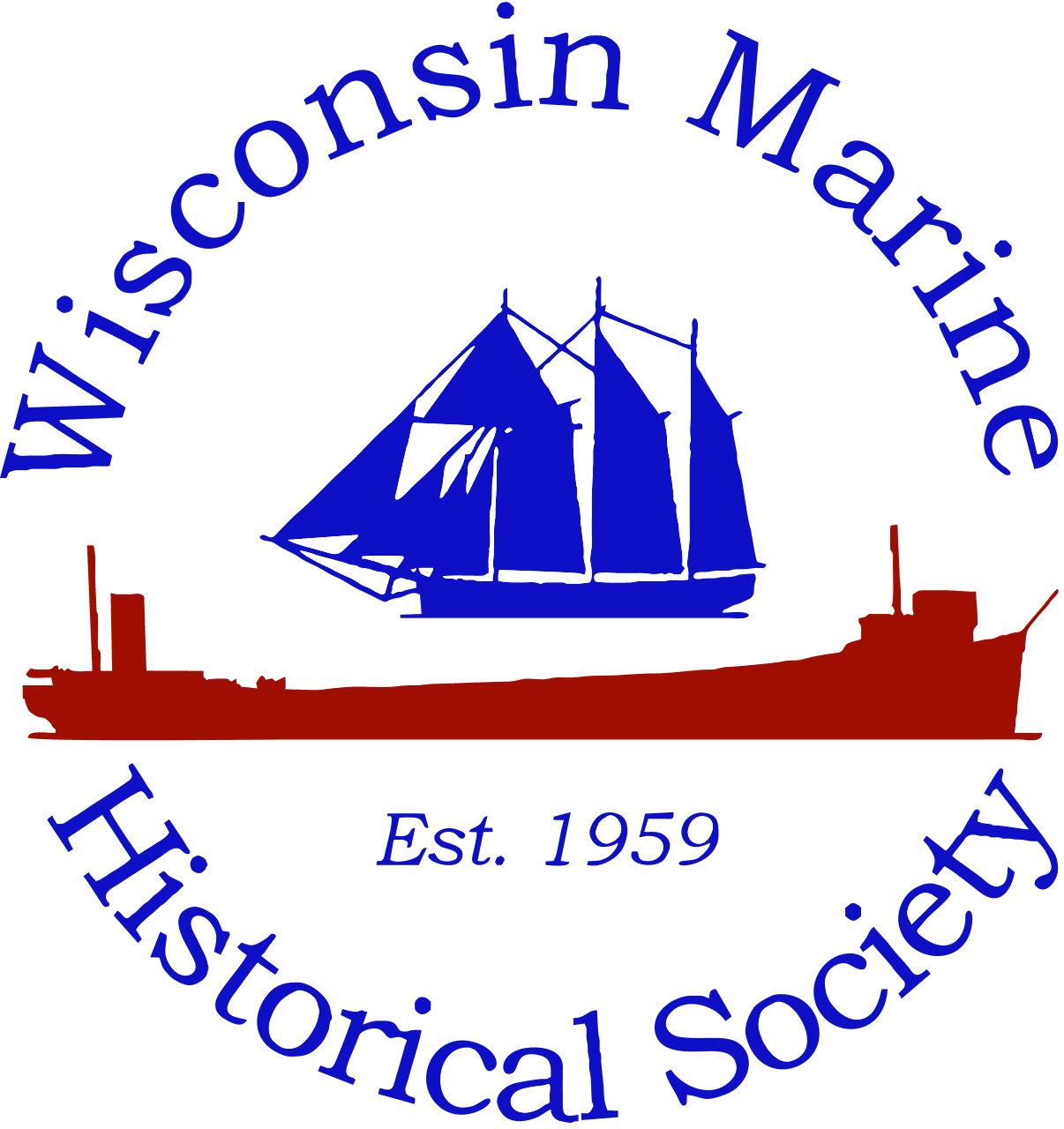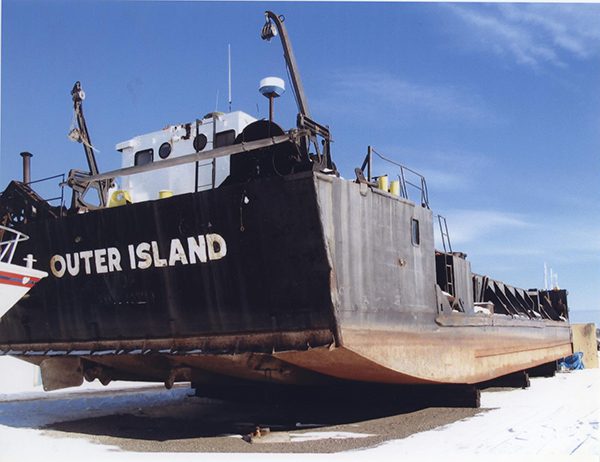By James Heinz
World War II ended nearly 76 years ago, yet some U.S. naval vessels continue to serve today on the Great Lakes.
The next time you’re in Bayfield, Wisconsin, you may see what was once a military landing craft berthed near the Blackhawk Marina. She now works as a freight barge named OUTER ISLAND.
This is her story.
During World War II Allied military planners faced the great challenge of putting soldiers, tanks and tons of munitions on shores under the vigilant eye of a fortified enemy.
The U. S. Navy designed nine different types of landing craft — LCTs, eight of which were produced, according to Wikipedia. The one that is pertinent to this story is the LCT Mark (5) 203. It was 114 feet, 2 inches long, with a beam of 32 feet, 8 inches, and a draft of 3 feet, six inches. It had a speed of 10 knots and a range of 700 nautical miles at 7 knots per hour. The vessel had a cargo capacity of 150 U.S. tons. For protection she had two single 20 millimeter anti-aircraft guns and two .50 caliber machine guns. The wheelhouse was shielded with two and a half inch steel armor.
––––––––––
Visit us on Facebook
––––––––––
The LCT had a capacity for eighty barrels of diesel fuel that fed three Grey Marine 6-71 engines and a diesel-drive 20 kilowatt, 120 volt DC generator with three propellers that produced a shaft horsepower of 675.
The Bayfield LCT was built in 1942 at Bison Shipbuilding Corp, North Tonawanda, New York, and delivered to the Navy on Oct. 16. During her tenure, this LCT participated in the Allied invasion of Sicily, the battle of Anzio, and the invasion of Provence, France, code named Operation Dragoon. After the war, LCT (5) 203 was sold for merchant service.
For her service, she earned three battle stars. Only three World War II LCTs are still in existence — one in England, one in Israel, and the vessel in Bayfield, Wikipedia reports.
At this point, Public Television’s History Detectives program picks up the story. In 2001, a Navy vet named Doug Swanson, following a tip from another veteran, found what he thought was an LCT in Bayfield Harbor. The locals believed it had been a LCT 103, and had taken part in the Normandy landings. History Detective Elyse Luray discovered that the LCT was number 203, and confirmed that the Lullabye Furniture Company of Stevens Point, Wisconsin, had purchased the vessel in 1947. The firm named her M/V PLUSWOOD, assigning her to haul logs, according to an archived records of the Wisconsin Marine Historical Society.
Luray also discovered a report for LCT 203 in Operation Dragoon. In her words:
“And here, in these records, you really get a sense of what went on. It is early morning on
August 15th. An invasion force of some 900 warships and 1300 landing crafts lies off the
French coast, just south of St. Tropez. At 8.50 a.m., the first wave of 60,000 men lands on
three different beaches. The Outer Island, carrying 200 tons of ammunition, is sent to one
the most westerly beaches, Alpha Red, where the Germans have strung out their defenses.
In the chaos and confusion, the Outer Island is sent crisscrossing around the bay, in search
of a safe place to unload. Fighting on Alpha Red takes place until 10.40 a.m., when the 3rd
U.S. Infantry Division neutralizes the German defenses. Ten hours later, the Outer Island
finally lands. And over the next ten days, unloads some 1600 tons of armor and supplies.”
A website that records U.S. Navy history reports what happened to LCT(5) 203. Named after one of the Apostle Islands, OUTER ISLAND became a working barge In Bayfield, dredging, setting and building docks, hauling rocks and working on other marine construction. In 1964 the vessel was sold for $50,000 to Bayfield businessman and former mayor Ed Erickson. The vessel is now owned by Ken Dobson and berthed in the former Erickson Marina.
* * *
In 1970, OUTER ISLAND was the work platform for a research team led by the University of Wisconsin and the U.S. Coast Guard Oeanographic Office. The team was studying the Keweenaw Current, a flow of warm water along the peninsula’s northern shore. The National Park Service also has also chartered the barge to carry materials to the Apostle Islands.
The barge also spent four years in Racine helping lay the city’s water line from Lake Michigan.
In 2001, she served as the platform for a project led by Wisconsin’s Underwater Archeology Program.
True to her history, the vessel hosted reunions of World War II LCT sailors in 2003 and 2007. History Detectives paid to have “LCT 203” painted on the stern.
* * *
Photo at top:
The Bayfield LCT, named OUTER ISLAND, was built in 1942 at Bison Shipbuilding Corp, North Tonawanda, New York, and delivered to the Navy on Oct. 16. During her tenure, this LCT participated in the Allied invasion of Sicily, the battle of Anzio, and the invasion of Provence, France, code named Operation Dragoon. After the war, LCT (5) 203 was sold for merchant service. She now operates in Bayfield, Wisconsin. Photo Credit: Great Lakes Marine Collection – Milwaukee Public Library / Wisconsin Marine Historical Society
Another photo:

stars. Only three WW II LCTs are still in existence — one in England, one in Israel,
and the vessel in Bayfield, Wisconsin, Wikipedia reports. A previous owner of the
vessel named it PLUSWOOD. The Bayfield owner now calls it OUTER ISLAND.
Photo Credit: Great Lakes Marine Collection – Milwaukee Public Library /
Wisconsin Marine Historical Society
Story Resources:
http://www-tc.pbs.org/opb/historydetectives/static/media/transcripts/2011-04-20/203_LCT.pdf
http://ww2lct.org/mk5/201_250/lct203.htm
James Heinz is the Wisconsin Marine Historical Society’s acquisitions director. He became interested in maritime history as a kid watching Jacques Cousteau’s adventures on TV. He was a Great Lakes wreck diver until three episodes of the bends forced him to retire from diving. He was a University of Wisconsin – Milwaukee police officer for thirty years. He regularly flies either a Cessna 152 or 172.

